Improving Mental Health: Addressing Depressive Disorder in Australia
VerifiedAdded on 2023/04/21
|7
|1761
|406
Report
AI Summary
This report focuses on depressive disorder as a significant public health concern in Australia, highlighting the educational gaps that contribute to its prevalence and impact. It reviews literature to identify these gaps, noting that many individuals do not seek early clinical assistance due to a lack of awareness, stigma, financial factors, and personal beliefs. The report emphasizes the negative impact of this lack of knowledge, affecting individuals' ability to function normally and worsening other chronic conditions. The target audience for educational interventions includes patients at risk, their families, and the broader community. The proposed educational tool involves community-based teaching sessions to raise awareness about risk factors, promote emotional well-being, reduce stigma, and encourage supportive conversations. The session includes videos, presentations, personal stories, and information on support options and treatments, aiming to improve knowledge and reduce the prevalence of depression. Desklib provides a platform to access this and other similar resources for students.
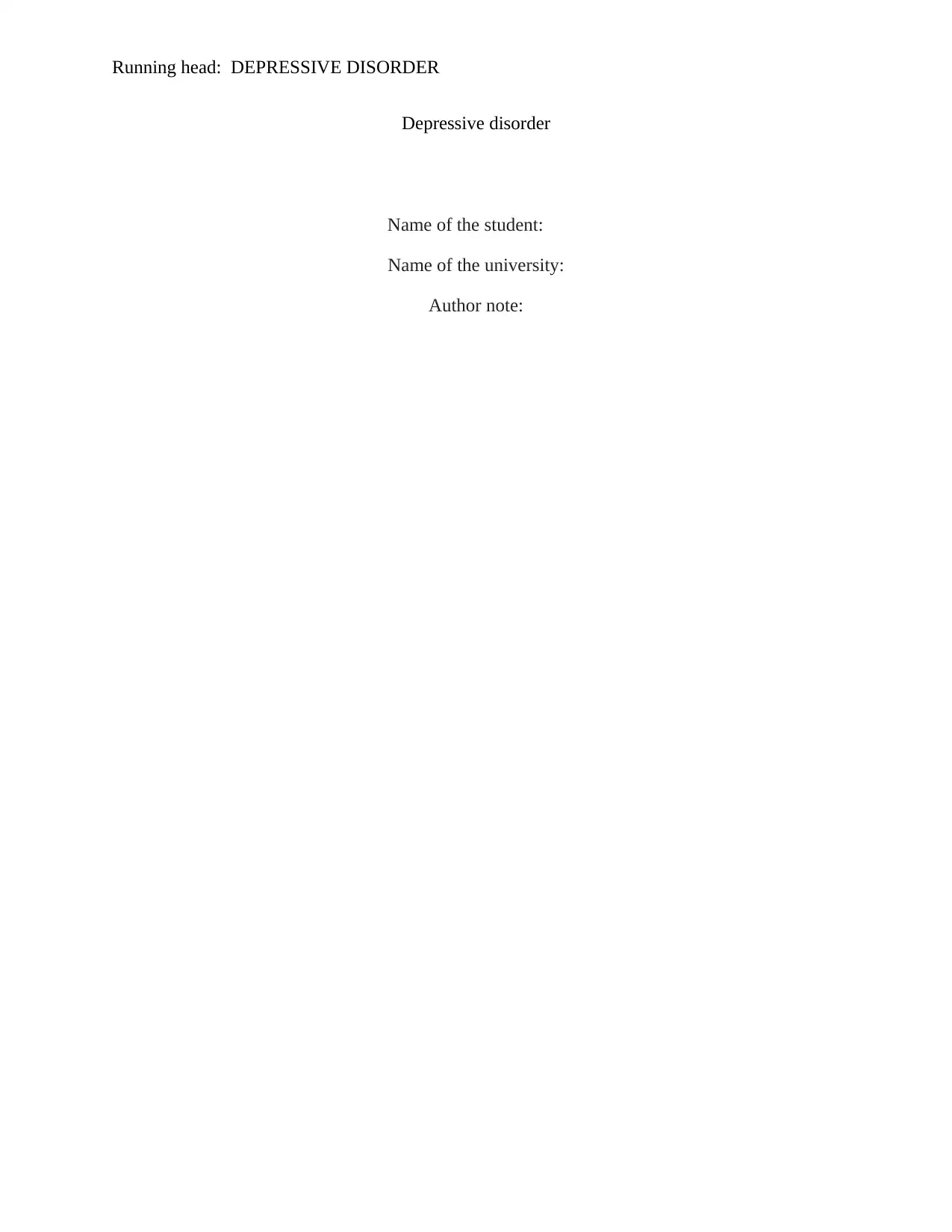
Running head: DEPRESSIVE DISORDER
Depressive disorder
Name of the student:
Name of the university:
Author note:
Depressive disorder
Name of the student:
Name of the university:
Author note:
Paraphrase This Document
Need a fresh take? Get an instant paraphrase of this document with our AI Paraphraser
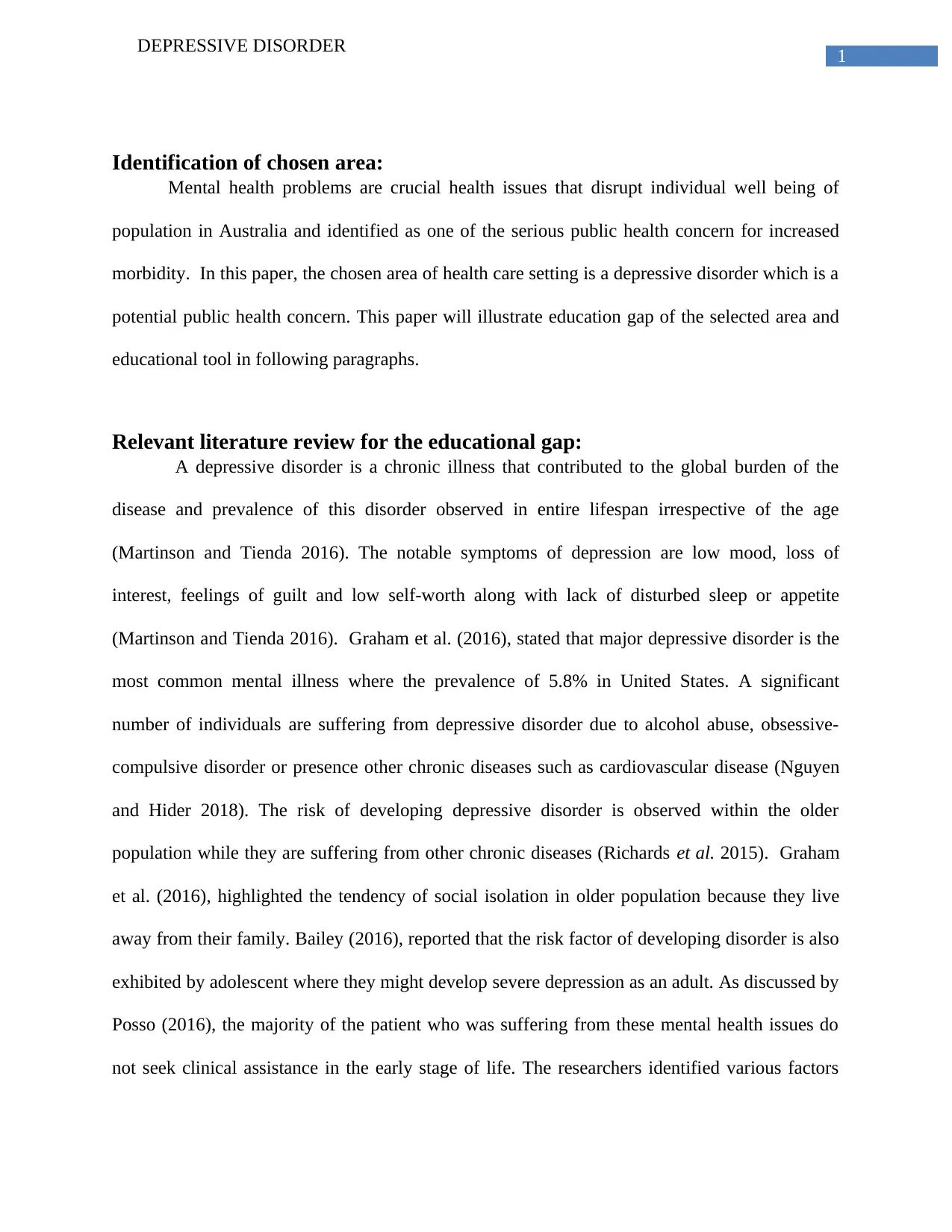
1
DEPRESSIVE DISORDER
Identification of chosen area:
Mental health problems are crucial health issues that disrupt individual well being of
population in Australia and identified as one of the serious public health concern for increased
morbidity. In this paper, the chosen area of health care setting is a depressive disorder which is a
potential public health concern. This paper will illustrate education gap of the selected area and
educational tool in following paragraphs.
Relevant literature review for the educational gap:
A depressive disorder is a chronic illness that contributed to the global burden of the
disease and prevalence of this disorder observed in entire lifespan irrespective of the age
(Martinson and Tienda 2016). The notable symptoms of depression are low mood, loss of
interest, feelings of guilt and low self-worth along with lack of disturbed sleep or appetite
(Martinson and Tienda 2016). Graham et al. (2016), stated that major depressive disorder is the
most common mental illness where the prevalence of 5.8% in United States. A significant
number of individuals are suffering from depressive disorder due to alcohol abuse, obsessive-
compulsive disorder or presence other chronic diseases such as cardiovascular disease (Nguyen
and Hider 2018). The risk of developing depressive disorder is observed within the older
population while they are suffering from other chronic diseases (Richards et al. 2015). Graham
et al. (2016), highlighted the tendency of social isolation in older population because they live
away from their family. Bailey (2016), reported that the risk factor of developing disorder is also
exhibited by adolescent where they might develop severe depression as an adult. As discussed by
Posso (2016), the majority of the patient who was suffering from these mental health issues do
not seek clinical assistance in the early stage of life. The researchers identified various factors
DEPRESSIVE DISORDER
Identification of chosen area:
Mental health problems are crucial health issues that disrupt individual well being of
population in Australia and identified as one of the serious public health concern for increased
morbidity. In this paper, the chosen area of health care setting is a depressive disorder which is a
potential public health concern. This paper will illustrate education gap of the selected area and
educational tool in following paragraphs.
Relevant literature review for the educational gap:
A depressive disorder is a chronic illness that contributed to the global burden of the
disease and prevalence of this disorder observed in entire lifespan irrespective of the age
(Martinson and Tienda 2016). The notable symptoms of depression are low mood, loss of
interest, feelings of guilt and low self-worth along with lack of disturbed sleep or appetite
(Martinson and Tienda 2016). Graham et al. (2016), stated that major depressive disorder is the
most common mental illness where the prevalence of 5.8% in United States. A significant
number of individuals are suffering from depressive disorder due to alcohol abuse, obsessive-
compulsive disorder or presence other chronic diseases such as cardiovascular disease (Nguyen
and Hider 2018). The risk of developing depressive disorder is observed within the older
population while they are suffering from other chronic diseases (Richards et al. 2015). Graham
et al. (2016), highlighted the tendency of social isolation in older population because they live
away from their family. Bailey (2016), reported that the risk factor of developing disorder is also
exhibited by adolescent where they might develop severe depression as an adult. As discussed by
Posso (2016), the majority of the patient who was suffering from these mental health issues do
not seek clinical assistance in the early stage of life. The researchers identified various factors
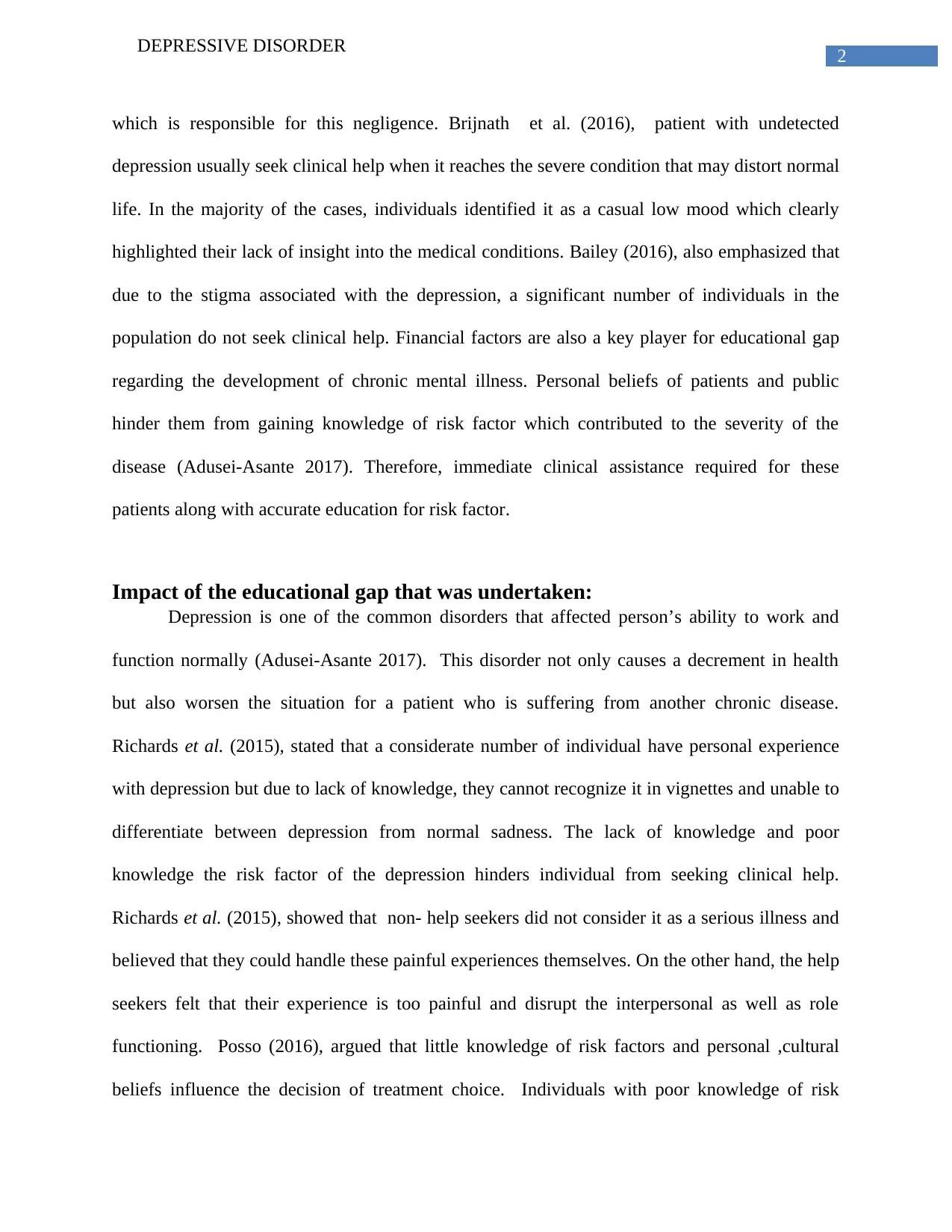
2
DEPRESSIVE DISORDER
which is responsible for this negligence. Brijnath et al. (2016), patient with undetected
depression usually seek clinical help when it reaches the severe condition that may distort normal
life. In the majority of the cases, individuals identified it as a casual low mood which clearly
highlighted their lack of insight into the medical conditions. Bailey (2016), also emphasized that
due to the stigma associated with the depression, a significant number of individuals in the
population do not seek clinical help. Financial factors are also a key player for educational gap
regarding the development of chronic mental illness. Personal beliefs of patients and public
hinder them from gaining knowledge of risk factor which contributed to the severity of the
disease (Adusei-Asante 2017). Therefore, immediate clinical assistance required for these
patients along with accurate education for risk factor.
Impact of the educational gap that was undertaken:
Depression is one of the common disorders that affected person’s ability to work and
function normally (Adusei-Asante 2017). This disorder not only causes a decrement in health
but also worsen the situation for a patient who is suffering from another chronic disease.
Richards et al. (2015), stated that a considerate number of individual have personal experience
with depression but due to lack of knowledge, they cannot recognize it in vignettes and unable to
differentiate between depression from normal sadness. The lack of knowledge and poor
knowledge the risk factor of the depression hinders individual from seeking clinical help.
Richards et al. (2015), showed that non- help seekers did not consider it as a serious illness and
believed that they could handle these painful experiences themselves. On the other hand, the help
seekers felt that their experience is too painful and disrupt the interpersonal as well as role
functioning. Posso (2016), argued that little knowledge of risk factors and personal ,cultural
beliefs influence the decision of treatment choice. Individuals with poor knowledge of risk
DEPRESSIVE DISORDER
which is responsible for this negligence. Brijnath et al. (2016), patient with undetected
depression usually seek clinical help when it reaches the severe condition that may distort normal
life. In the majority of the cases, individuals identified it as a casual low mood which clearly
highlighted their lack of insight into the medical conditions. Bailey (2016), also emphasized that
due to the stigma associated with the depression, a significant number of individuals in the
population do not seek clinical help. Financial factors are also a key player for educational gap
regarding the development of chronic mental illness. Personal beliefs of patients and public
hinder them from gaining knowledge of risk factor which contributed to the severity of the
disease (Adusei-Asante 2017). Therefore, immediate clinical assistance required for these
patients along with accurate education for risk factor.
Impact of the educational gap that was undertaken:
Depression is one of the common disorders that affected person’s ability to work and
function normally (Adusei-Asante 2017). This disorder not only causes a decrement in health
but also worsen the situation for a patient who is suffering from another chronic disease.
Richards et al. (2015), stated that a considerate number of individual have personal experience
with depression but due to lack of knowledge, they cannot recognize it in vignettes and unable to
differentiate between depression from normal sadness. The lack of knowledge and poor
knowledge the risk factor of the depression hinders individual from seeking clinical help.
Richards et al. (2015), showed that non- help seekers did not consider it as a serious illness and
believed that they could handle these painful experiences themselves. On the other hand, the help
seekers felt that their experience is too painful and disrupt the interpersonal as well as role
functioning. Posso (2016), argued that little knowledge of risk factors and personal ,cultural
beliefs influence the decision of treatment choice. Individuals with poor knowledge of risk
⊘ This is a preview!⊘
Do you want full access?
Subscribe today to unlock all pages.

Trusted by 1+ million students worldwide
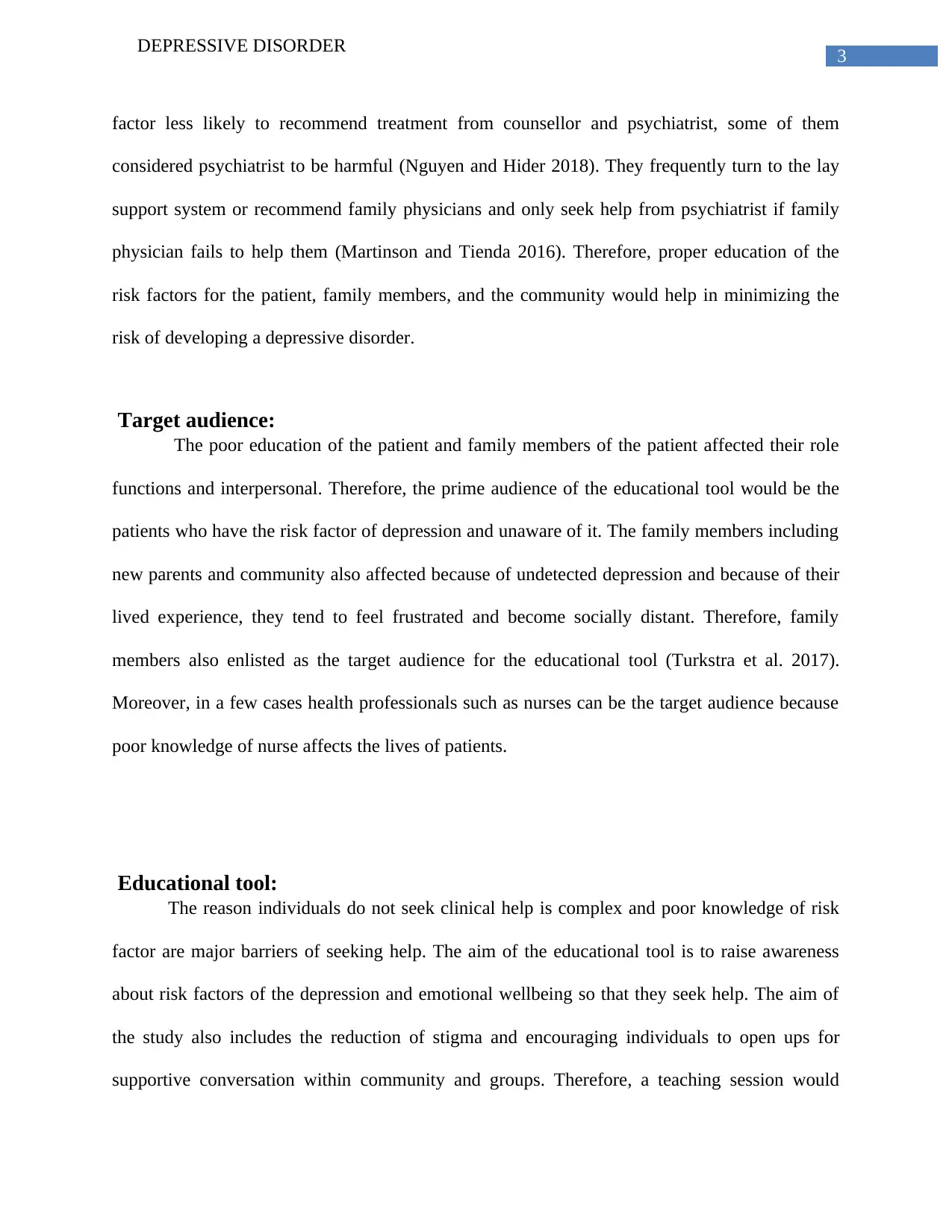
3
DEPRESSIVE DISORDER
factor less likely to recommend treatment from counsellor and psychiatrist, some of them
considered psychiatrist to be harmful (Nguyen and Hider 2018). They frequently turn to the lay
support system or recommend family physicians and only seek help from psychiatrist if family
physician fails to help them (Martinson and Tienda 2016). Therefore, proper education of the
risk factors for the patient, family members, and the community would help in minimizing the
risk of developing a depressive disorder.
Target audience:
The poor education of the patient and family members of the patient affected their role
functions and interpersonal. Therefore, the prime audience of the educational tool would be the
patients who have the risk factor of depression and unaware of it. The family members including
new parents and community also affected because of undetected depression and because of their
lived experience, they tend to feel frustrated and become socially distant. Therefore, family
members also enlisted as the target audience for the educational tool (Turkstra et al. 2017).
Moreover, in a few cases health professionals such as nurses can be the target audience because
poor knowledge of nurse affects the lives of patients.
Educational tool:
The reason individuals do not seek clinical help is complex and poor knowledge of risk
factor are major barriers of seeking help. The aim of the educational tool is to raise awareness
about risk factors of the depression and emotional wellbeing so that they seek help. The aim of
the study also includes the reduction of stigma and encouraging individuals to open ups for
supportive conversation within community and groups. Therefore, a teaching session would
DEPRESSIVE DISORDER
factor less likely to recommend treatment from counsellor and psychiatrist, some of them
considered psychiatrist to be harmful (Nguyen and Hider 2018). They frequently turn to the lay
support system or recommend family physicians and only seek help from psychiatrist if family
physician fails to help them (Martinson and Tienda 2016). Therefore, proper education of the
risk factors for the patient, family members, and the community would help in minimizing the
risk of developing a depressive disorder.
Target audience:
The poor education of the patient and family members of the patient affected their role
functions and interpersonal. Therefore, the prime audience of the educational tool would be the
patients who have the risk factor of depression and unaware of it. The family members including
new parents and community also affected because of undetected depression and because of their
lived experience, they tend to feel frustrated and become socially distant. Therefore, family
members also enlisted as the target audience for the educational tool (Turkstra et al. 2017).
Moreover, in a few cases health professionals such as nurses can be the target audience because
poor knowledge of nurse affects the lives of patients.
Educational tool:
The reason individuals do not seek clinical help is complex and poor knowledge of risk
factor are major barriers of seeking help. The aim of the educational tool is to raise awareness
about risk factors of the depression and emotional wellbeing so that they seek help. The aim of
the study also includes the reduction of stigma and encouraging individuals to open ups for
supportive conversation within community and groups. Therefore, a teaching session would
Paraphrase This Document
Need a fresh take? Get an instant paraphrase of this document with our AI Paraphraser
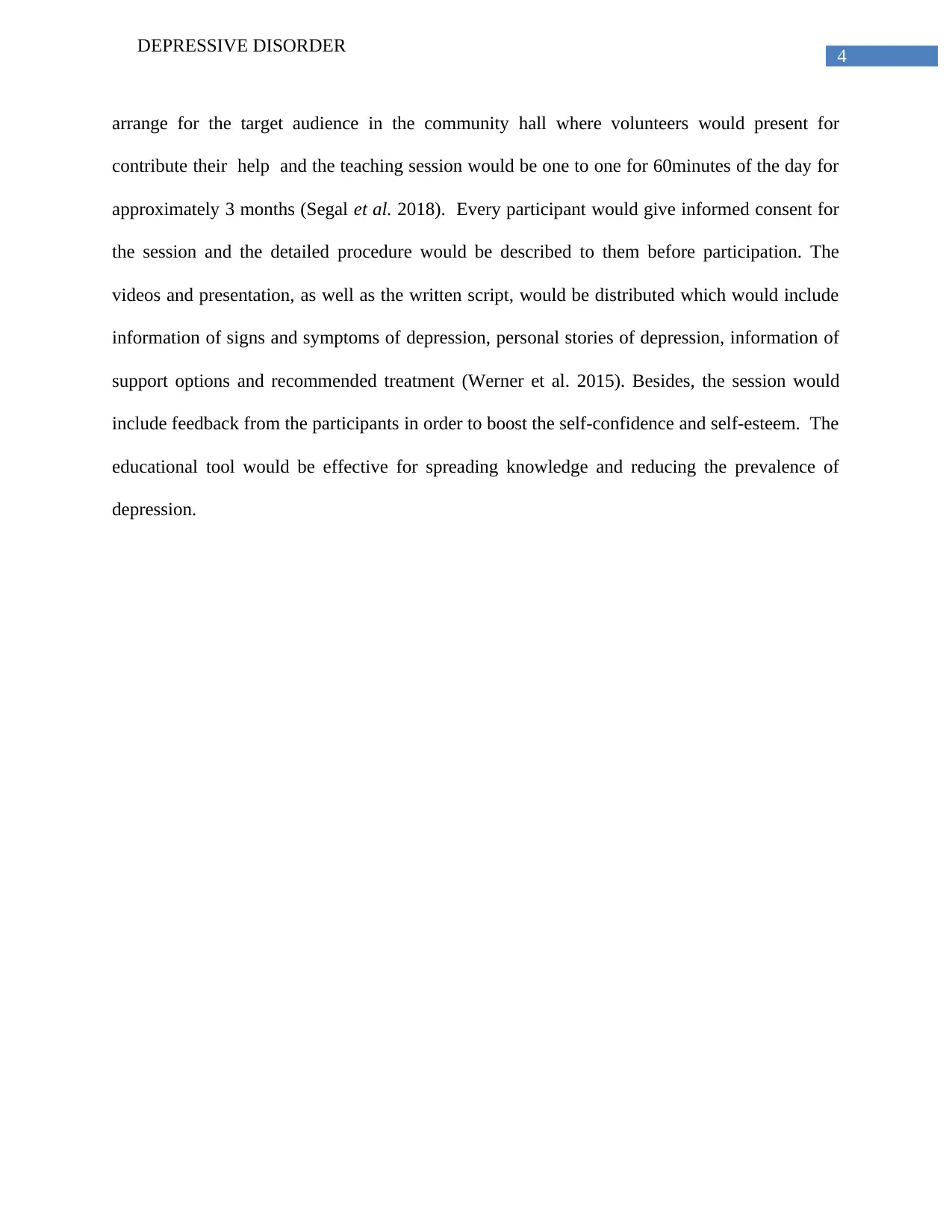
4
DEPRESSIVE DISORDER
arrange for the target audience in the community hall where volunteers would present for
contribute their help and the teaching session would be one to one for 60minutes of the day for
approximately 3 months (Segal et al. 2018). Every participant would give informed consent for
the session and the detailed procedure would be described to them before participation. The
videos and presentation, as well as the written script, would be distributed which would include
information of signs and symptoms of depression, personal stories of depression, information of
support options and recommended treatment (Werner et al. 2015). Besides, the session would
include feedback from the participants in order to boost the self-confidence and self-esteem. The
educational tool would be effective for spreading knowledge and reducing the prevalence of
depression.
DEPRESSIVE DISORDER
arrange for the target audience in the community hall where volunteers would present for
contribute their help and the teaching session would be one to one for 60minutes of the day for
approximately 3 months (Segal et al. 2018). Every participant would give informed consent for
the session and the detailed procedure would be described to them before participation. The
videos and presentation, as well as the written script, would be distributed which would include
information of signs and symptoms of depression, personal stories of depression, information of
support options and recommended treatment (Werner et al. 2015). Besides, the session would
include feedback from the participants in order to boost the self-confidence and self-esteem. The
educational tool would be effective for spreading knowledge and reducing the prevalence of
depression.
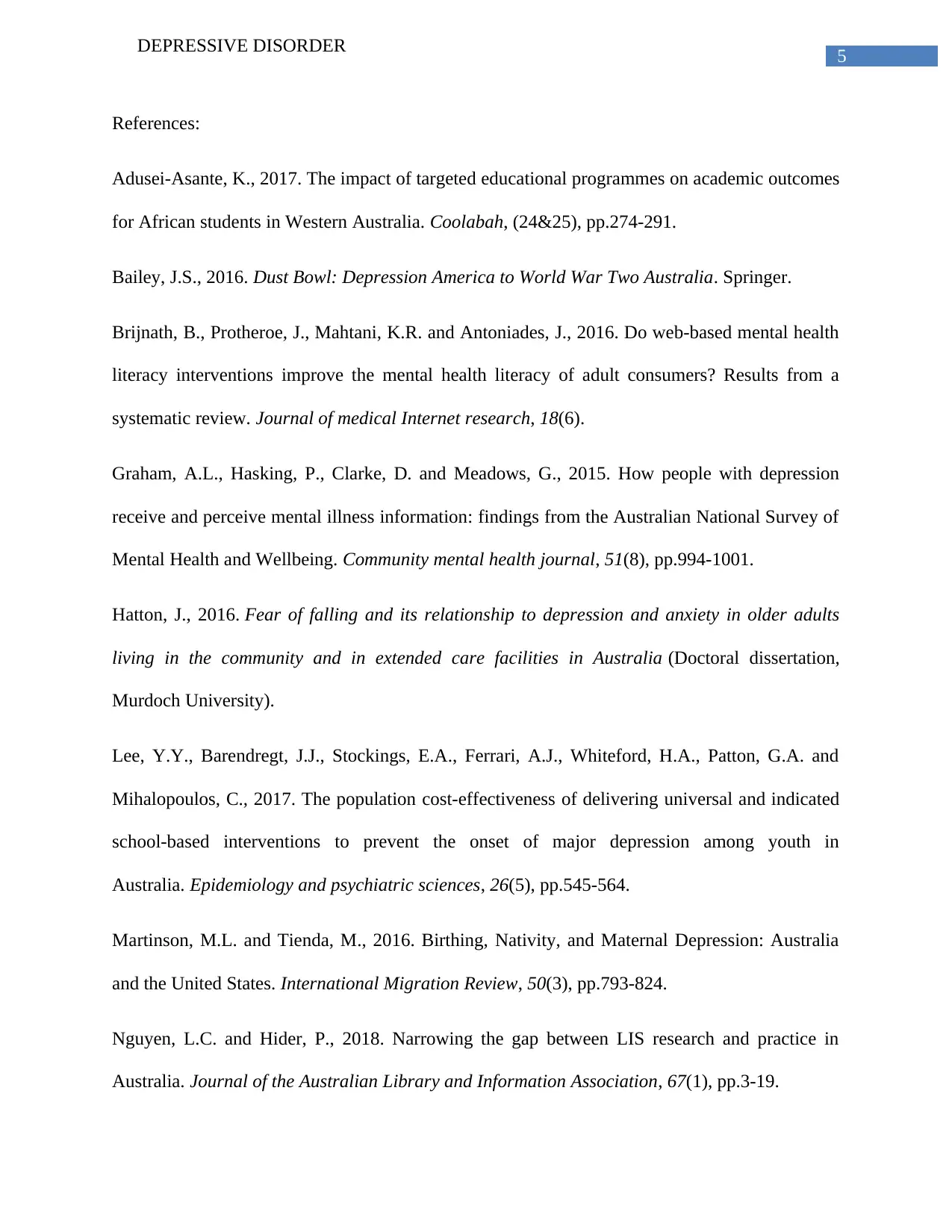
5
DEPRESSIVE DISORDER
References:
Adusei-Asante, K., 2017. The impact of targeted educational programmes on academic outcomes
for African students in Western Australia. Coolabah, (24&25), pp.274-291.
Bailey, J.S., 2016. Dust Bowl: Depression America to World War Two Australia. Springer.
Brijnath, B., Protheroe, J., Mahtani, K.R. and Antoniades, J., 2016. Do web-based mental health
literacy interventions improve the mental health literacy of adult consumers? Results from a
systematic review. Journal of medical Internet research, 18(6).
Graham, A.L., Hasking, P., Clarke, D. and Meadows, G., 2015. How people with depression
receive and perceive mental illness information: findings from the Australian National Survey of
Mental Health and Wellbeing. Community mental health journal, 51(8), pp.994-1001.
Hatton, J., 2016. Fear of falling and its relationship to depression and anxiety in older adults
living in the community and in extended care facilities in Australia (Doctoral dissertation,
Murdoch University).
Lee, Y.Y., Barendregt, J.J., Stockings, E.A., Ferrari, A.J., Whiteford, H.A., Patton, G.A. and
Mihalopoulos, C., 2017. The population cost-effectiveness of delivering universal and indicated
school-based interventions to prevent the onset of major depression among youth in
Australia. Epidemiology and psychiatric sciences, 26(5), pp.545-564.
Martinson, M.L. and Tienda, M., 2016. Birthing, Nativity, and Maternal Depression: Australia
and the United States. International Migration Review, 50(3), pp.793-824.
Nguyen, L.C. and Hider, P., 2018. Narrowing the gap between LIS research and practice in
Australia. Journal of the Australian Library and Information Association, 67(1), pp.3-19.
DEPRESSIVE DISORDER
References:
Adusei-Asante, K., 2017. The impact of targeted educational programmes on academic outcomes
for African students in Western Australia. Coolabah, (24&25), pp.274-291.
Bailey, J.S., 2016. Dust Bowl: Depression America to World War Two Australia. Springer.
Brijnath, B., Protheroe, J., Mahtani, K.R. and Antoniades, J., 2016. Do web-based mental health
literacy interventions improve the mental health literacy of adult consumers? Results from a
systematic review. Journal of medical Internet research, 18(6).
Graham, A.L., Hasking, P., Clarke, D. and Meadows, G., 2015. How people with depression
receive and perceive mental illness information: findings from the Australian National Survey of
Mental Health and Wellbeing. Community mental health journal, 51(8), pp.994-1001.
Hatton, J., 2016. Fear of falling and its relationship to depression and anxiety in older adults
living in the community and in extended care facilities in Australia (Doctoral dissertation,
Murdoch University).
Lee, Y.Y., Barendregt, J.J., Stockings, E.A., Ferrari, A.J., Whiteford, H.A., Patton, G.A. and
Mihalopoulos, C., 2017. The population cost-effectiveness of delivering universal and indicated
school-based interventions to prevent the onset of major depression among youth in
Australia. Epidemiology and psychiatric sciences, 26(5), pp.545-564.
Martinson, M.L. and Tienda, M., 2016. Birthing, Nativity, and Maternal Depression: Australia
and the United States. International Migration Review, 50(3), pp.793-824.
Nguyen, L.C. and Hider, P., 2018. Narrowing the gap between LIS research and practice in
Australia. Journal of the Australian Library and Information Association, 67(1), pp.3-19.
⊘ This is a preview!⊘
Do you want full access?
Subscribe today to unlock all pages.

Trusted by 1+ million students worldwide
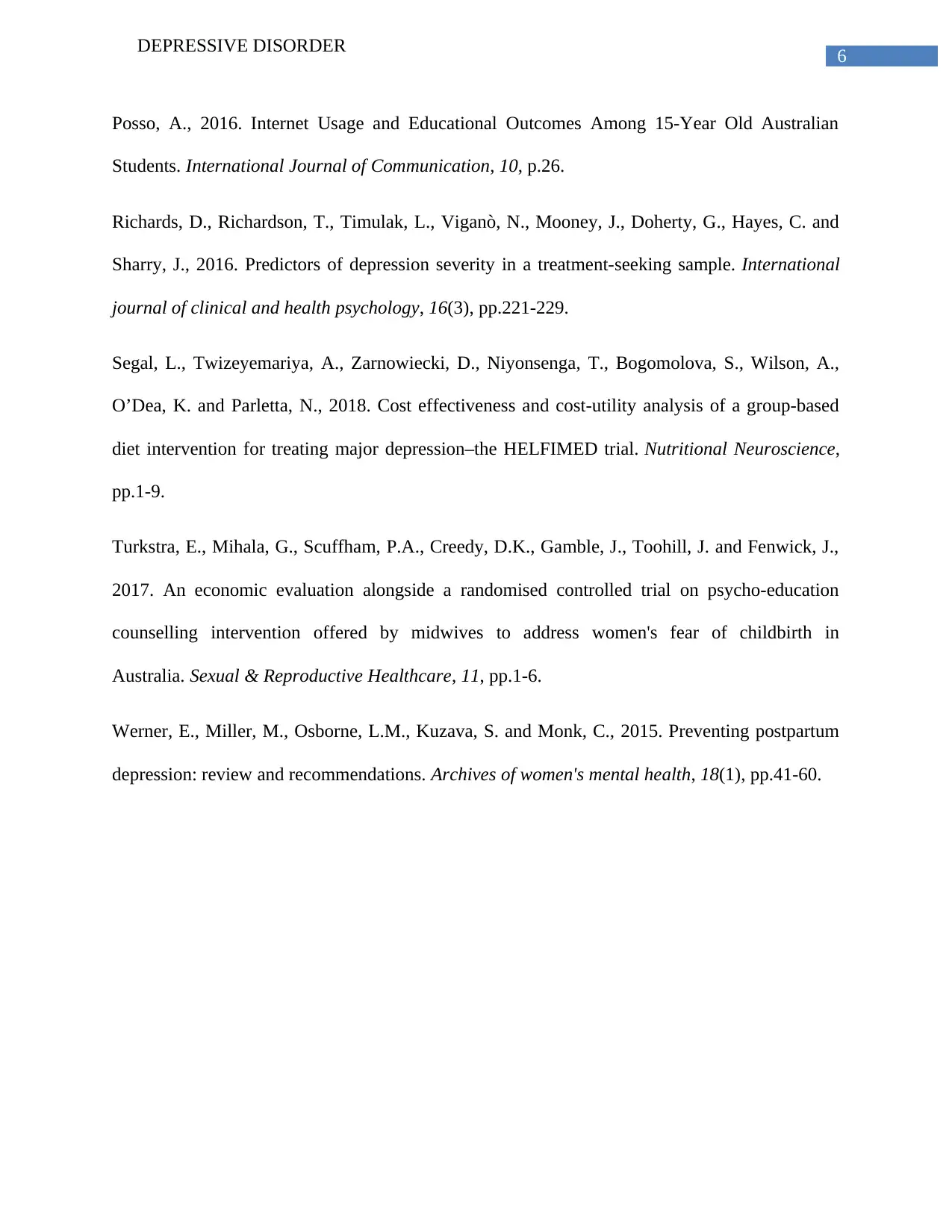
6
DEPRESSIVE DISORDER
Posso, A., 2016. Internet Usage and Educational Outcomes Among 15-Year Old Australian
Students. International Journal of Communication, 10, p.26.
Richards, D., Richardson, T., Timulak, L., Viganò, N., Mooney, J., Doherty, G., Hayes, C. and
Sharry, J., 2016. Predictors of depression severity in a treatment-seeking sample. International
journal of clinical and health psychology, 16(3), pp.221-229.
Segal, L., Twizeyemariya, A., Zarnowiecki, D., Niyonsenga, T., Bogomolova, S., Wilson, A.,
O’Dea, K. and Parletta, N., 2018. Cost effectiveness and cost-utility analysis of a group-based
diet intervention for treating major depression–the HELFIMED trial. Nutritional Neuroscience,
pp.1-9.
Turkstra, E., Mihala, G., Scuffham, P.A., Creedy, D.K., Gamble, J., Toohill, J. and Fenwick, J.,
2017. An economic evaluation alongside a randomised controlled trial on psycho-education
counselling intervention offered by midwives to address women's fear of childbirth in
Australia. Sexual & Reproductive Healthcare, 11, pp.1-6.
Werner, E., Miller, M., Osborne, L.M., Kuzava, S. and Monk, C., 2015. Preventing postpartum
depression: review and recommendations. Archives of women's mental health, 18(1), pp.41-60.
DEPRESSIVE DISORDER
Posso, A., 2016. Internet Usage and Educational Outcomes Among 15-Year Old Australian
Students. International Journal of Communication, 10, p.26.
Richards, D., Richardson, T., Timulak, L., Viganò, N., Mooney, J., Doherty, G., Hayes, C. and
Sharry, J., 2016. Predictors of depression severity in a treatment-seeking sample. International
journal of clinical and health psychology, 16(3), pp.221-229.
Segal, L., Twizeyemariya, A., Zarnowiecki, D., Niyonsenga, T., Bogomolova, S., Wilson, A.,
O’Dea, K. and Parletta, N., 2018. Cost effectiveness and cost-utility analysis of a group-based
diet intervention for treating major depression–the HELFIMED trial. Nutritional Neuroscience,
pp.1-9.
Turkstra, E., Mihala, G., Scuffham, P.A., Creedy, D.K., Gamble, J., Toohill, J. and Fenwick, J.,
2017. An economic evaluation alongside a randomised controlled trial on psycho-education
counselling intervention offered by midwives to address women's fear of childbirth in
Australia. Sexual & Reproductive Healthcare, 11, pp.1-6.
Werner, E., Miller, M., Osborne, L.M., Kuzava, S. and Monk, C., 2015. Preventing postpartum
depression: review and recommendations. Archives of women's mental health, 18(1), pp.41-60.
1 out of 7
Related Documents
Your All-in-One AI-Powered Toolkit for Academic Success.
+13062052269
info@desklib.com
Available 24*7 on WhatsApp / Email
![[object Object]](/_next/static/media/star-bottom.7253800d.svg)
Unlock your academic potential
Copyright © 2020–2025 A2Z Services. All Rights Reserved. Developed and managed by ZUCOL.





